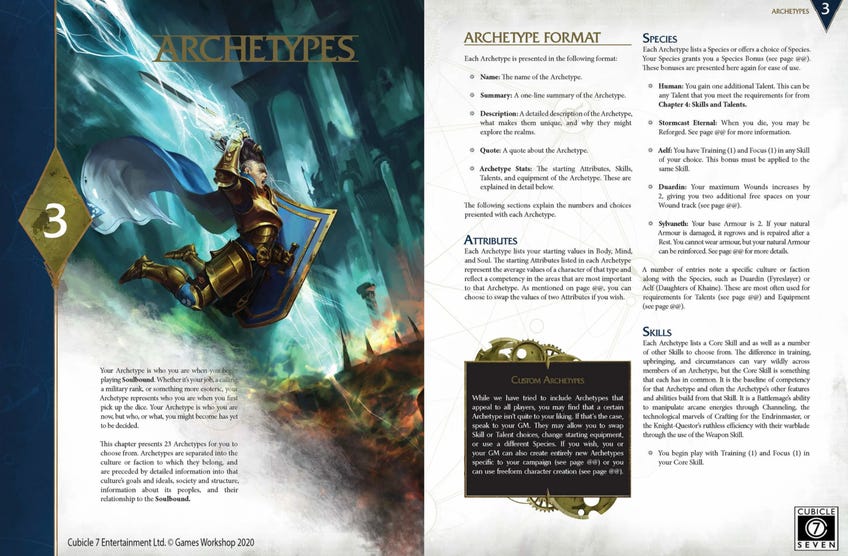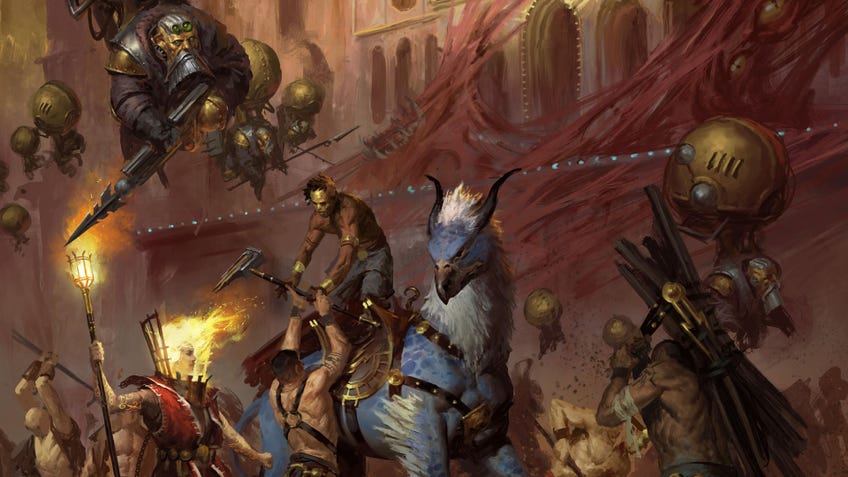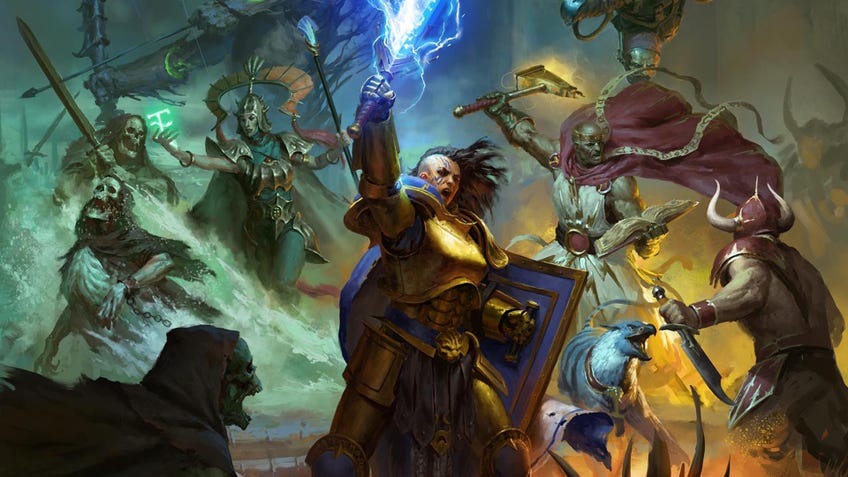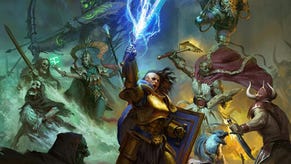Warhammer: Age of Sigmar - Soulbound RPG review: the ultimate power fantasy at the cost of subtlety
For the Seraphon of it.
If the ultimate goal of a tie-in is to capture the feel of the world it draws from, Warhammer: Age of Sigmar - Soulbound is a stellar success. Just like the Games Workshop miniatures wargame that birthed it, the first Age of Sigmar tabletop RPG has a slick design, a beautifully illustrated setting and a cast-iron commitment to telling only the highest of high-fantasy tales.
Most of these victories bleed over when you consider Soulbound as a standalone game too. Its complexity is somewhere on the lower side of action-heavy, tactical RPGs, but if you want to delve deeper into the system there’s also a fair bit of room for tinkering and customising your high-powered characters. This is especially true when it comes to the combat that lies at the heart of the game.
Perhaps the only chink in the game’s otherwise gleaming golden armour is that it lacks some of the feeling of growth that powers the session-to-session excitement of more traditional fantasy RPGs such as Dungeons & Dragons. This isn’t because of a lack of advancement options, mind, but rather a by-product of its cranked-up heroics.

If you walk into Soulbound expecting the kind of story where you start out clubbing rats in a grimy cellar and end up battling gods for control of the universe, you’re likely to be a little flummoxed. Even brand new characters are already marked by destiny for greatness and capable of pulling off incredible feats of martial or magical prowess, with storytelling arcs that are less zero-to-hero and more hero-to-superhero.
Soulbound's storytelling arcs are less zero-to-hero and more hero-to-superhero.
While it can be incredibly fun to flex your dice and pull off legendary feats from day one, this comes at the cost of making your character’s growth feel a little less impressive. If you run things by the book, many characters will play much the same way no matter whether you’re one day or one year into your campaign.
This display of might is perhaps a natural consequence of any game set in the Age of Sigmar cosmology, which has a much grander and knowingly epic design than its predecessor, the venerable Warhammer Fantasy. Rather than being content with just a single quasi-medieval world, Age of Sigmar embraces more than a half-dozen planes of reality, each with its own quirks to embrace and problems to overcome.

Unless you already have an intimate understanding of Warhammer lore it can be hard to get a handle on what the consequences of adventuring through these places might be. What the heck does an average day in the Realm of Beasts look like? If you love filling in blank space, however, there’s plenty of room for GMs to carve out their own domains and modify things to their heart’s content. The shamelessly mystical nature of the world makes it easy to slip in your wildest, coolest ideas without any fear of disrupting the feel of the game.
Soulbound does include optional rules for running more of a low-level campaign if you wish. However, the core conceit of the standard game makes it clear that the party isn’t just a selection of random adventurers thrown together by fate, but rather a special group of champions chosen by the gods to battle the forces of evil.
The heroes in question can be a rather diverse bunch of folks, with character options ranging all the way from elven sorceresses to quasi-immortal angelic snipers and everything in-between. The creativity on display is impressive, and virtually every archetype looks instantly appealing - it’s incredibly hard not to crack a grin while rolling up a dwarven gunsmith with a mystical hot air balloon strapped to their back.
It’s incredibly hard not to crack a grin while rolling up a dwarven gunsmith with a mystical hot air balloon strapped to their back.
If this all sounds like it must be rather complex to put together, you needn’t worry all that much. Character creation in Soulbound is a rather straightforward and entirely painless process; you’ll probably end up spending more time on your backstory and ties to the rest of the party than on the maths.
This mostly carries over into the core gameplay itself, where all checks and tests you might need to carry out are handled with a slick little dice pool system. As with many similar rulesets it works by having players overcome obstacles, whether they be a demon that needs whacking or a magical secret that needs unravelling, by assembling a pile of six-sided dice based on their stats and skills and trying to roll a certain number of successes.
What makes Soulbound’s rules a little different to most other tabletop RPGs is that it’s the GM’s role to set both the number of successes needed and the target number that the players need to roll. A comparatively simple but long-winded task, such as combing a town for leads, might require several easier rolls, while the short-lived but high-risk act of shooting through the hangman’s rope from across a crowd could hinge on rolling just a single six.

In theory it’s a clever idea that can be used to make checks feel more thematic. However, it does have a couple of quirks that might cause a couple of hiccups at the table - perhaps the most important of which is that it can sometimes be tough for GMs to know how hard their tests are.
Soulbound really shines in combat, managing a decent blend of tactical gameplay and fast-paced action.
Now, there may be some very probability-savvy folks out there who would immediately be able to tell you how things stack up between the chances of rolling a single six or a trio of four-plusses. If we’re being honest, though, many of us are going to struggle to get a real feel for the odds at a glance.
This may be something that will come with time and, in fairness, there is an expansive chart laying out dozens and dozens of possibilities buried in Soulbound’s rulebook. Even so, it can sometimes make for a disconcerting GMing experience and drive home why most tabletop roleplaying games stick to fiddling with just one variable when it comes to difficulty.

Fortunately, this potential lack of confidence isn’t something that impacts possibly the most pivotal part of the game: combat. The core rules all work the same way but, rather than being decided by the GM, all difficulties are determined by comparing stats, with extra successes on attacks translating into bonus damage.
This is where Soulbound really shines. With a nicely abstract system for dividing up the battlefield into zones, it manages a decent blend of tactical gameplay and fast-paced action. If nothing else, it might be one of the first tabletop RPGs out there to write called shot rules - strikes aimed specifically at the head, legs, that kind of thing - that don’t drag down combat or break the system wide open.
It may not be the most subtle experience out there - in fact, it may be one of the least subtle games in existence - but Warhammer: Age of Sigmar - Soulbound confidently sets out its goals right from the start. If you want both your fantasy and power levels set to sky-high, it may well be the roleplaying game for you.


